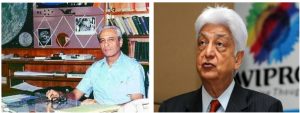
The IISc-Wipro connection was formally initiated in 1979. In this picture, you see the two visionaries that led the two institutions at the time of initiation, Satish Dhawan, Director of IISc (1963-1981) and Azim Hashim Premji, the Architect of Wipro. This collaboration has sustained for more than four decades, with IISc and Wipro collaborating on various endeavours, including the IISc-Wipro-DHI Initiative on Metal-based Additive Manufacturing, the Wipro GE Healthcare Collaborative Laboratory in Medical Imaging, the Wipro-IISc Research and Innovation Network (WIRIN), and Implementing SAP S/4 HANA for Transforming Administration and Research (ISTAR).
In this article compiled by Yadati Narahari, with inputs from knowledgeable sources, he recounts how SA and CEDT at IISc have played a key role in the establishment of Wipro Information Technology Limited.
Role of the Indian Institute of Science, School of Automation, and CEDT in the launching of Wipro’s Computer business
— Yadati Narahari
In the late 1970s, many industrial houses in India were trying to make inroads into the then nascent business of computers to fill the vacuum created by the departure of IBM in 1977. Around the same time, global markets were transitioning from the paradigm of proprietary mainframes to that of open systems. In the absence of an organised computer hardware industry in India, some companies started to explore manufacturing eight-bit microprocessor-based systems to address low-end data processing requirements.
Wipro Products Limited (earlier Western India Vegetable Products Limited) headed by Azim H Premji was one such enterprising company that decided to foray into the Indian computer market. At that time, Premji had met and was impressed by Ashok Narasimhan, who worked as the financial controller at TELCO in Pune and convinced him to join Wipro as its General Manager of Finance & Planning, to help set-up its computer business. Their vision was to build minicomputers that would offer an exceptional performance, at a price point that was suitable for the Indian market.
Wipro looked to the Indian Institute of Science (IISc) for the required technology knowhow and expertise in this nascent space. At that time, the Digital Systems Lab of the School of Automation (now the Department of Computer Science and Automation – CSA) in IISc, headed by Dr N J Rao, was offering courses in microprocessors and had developed a substantial amount of expertise and knowledge in the area.
Additionally, the Centre for Electronic Design and Technology (CEDT) at IISc, set up with Swiss collaboration, was offering practical courses in building microprocessor-based systems. CEDT placed much emphasis on system design including both hardware and software. Dr Serge Boada and Dr H S Jamadagni, faculty members of CEDT, had started working on sixteen-bit microprocessors. IISc had just then established the Centre for Scientific and Industrial Consultancy (CSIC) to promote collaboration between IISc and the industry.
To formalise its partnership with IISc, Wipro awarded a consultancy project to IISc’s Dr N J Rao through CSIC, and an agreement was signed in July 1979. A letter dated October 5, 1979, from the Registrar, IISc to Ashok Narasimhan, states the following: ‘The Indian Institute of Science has undertaken a project for the Design and Development of Microprocessor based Mini-computer systems for M/s. Wipro Products Limited, Bombay. It is envisaged that the Design and Production know-how would be transferred to M/s. Wipro Products Limited, Bombay approximately in the next 15 months. Preliminary work on the project has been carried out during the last four months.’
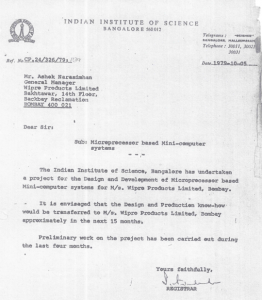
The value of the consulting project was approximately Rs 14 lakhs. The consulting project had two objectives:
As a part of this consultancy project, IISc imported the Intel Microprocessor Development System and development tools. The system was used by the Wipro developers and students and faculty members of IISc and was installed in the Digital Systems Lab in 1981. Prof N J Rao, Dr Serge Boada, Prof Jamadagni, and Dr Chakrapani were involved in this consultancy project. Soon, Victor Jayakaran, who had completed ME at the School of Automation, became a part of this team.
Around the same time, Wipro brought on board Dr Sridhar Mitta, who had several years of systems engineering experience from the Electronics Corporation of India Limited (ECIL) to join as its Research & Development Manager in May 1980. Meanwhile, Victor Jayakaran joined Wipro formally as its first employee. The computer business was named as Wipro Information Technology Limited and became a subsidiary of Wipro Products Limited. It was headquartered in Bangalore with plans to setup the manufacturing facilities in Mysore.
During the first few months of the consulting project, Sridhar Mitta and Victor Jayakaran worked out of the Digital Systems Lab in the School of Automation. This facilitated close interactions between the members of consulting project at IISc and the Wipro team. The joint discussions resulted in the creation of the system architecture of Wipro’s first computer system. It included:
These fundamental decisions made during the consultancy phase with IISc resulted in a clear structured architectural orientation of the project, which catalysed the success of Wipro’s first sixteen-bit microprocessor-based minicomputer system – Wipro Series-86.
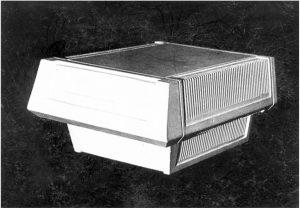
(b) Plaster of Paris model of final design for the housing
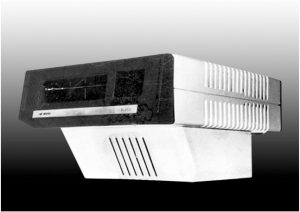
(a) First prototype of Wipro computer housing made out of fibreglass moulding
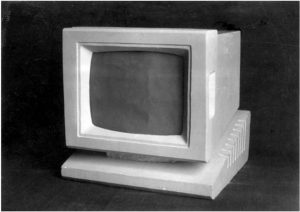
(d) Overall housing
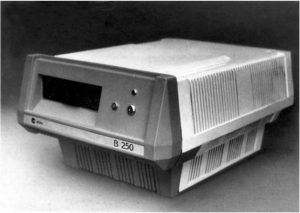
(c) Production version of the computer housing made in structural foam moulding
Figure: Genesis of the Wipro Series-86 machine
It was India’s first machine with multiuser, multitasking, and database-oriented operating system features with 16 terminals, addressing enterprise business applications. The chosen architecture was so robust it served Wipro for the next three generations with Series-286 and Series-386. Further, it provided unprecedented compatibility with previous generations of systems, protecting the investments made by Wipro and its customers. This enabled Wipro to surge ahead of the competition and establish itself as a technology-driven company in the Indian computer market.
Wipro recruited two graduates from the IISc – Vallab Kulkarni and Srikant Seshadri. In addition, several experienced executives from ECIL joined Wipro both for R&D and manufacturing. By then, the Wipro team shifted to its first formal office at 45, Dickenson Road in Bangalore. During 1981, Anand Talwai who did his MTech in Physical Engineering in 1979 joined Wipro as its first Quality Assurance Manager after working at the Indian Space Research Organisation. Anand Talwai headed the quality and customer satisfaction functions in Wipro and built its communications division. Anujan, Varma, Ravi Bail, and several other students from School of Automation and CEDT joined Wipro to form the early core group of Wipro employees.
It is appropriate to recognise the fact that School of Automation and CEDT at IISc have played a key role in the establishment of Wipro Information Technology Limited. The strong foundation contributed to Wipro reaching a leadership position in Indian computer industry. It is indeed a matter of pride that IISc played a deep technical role in inspiring the launching of Wipro’s computer business.
This document was prepared based on the following meetings and documents.
Another article on The Birth of Wipro’s Computer Systems Business by Rohini Krishnamurthy was published in IISc’s Connect magazine. You can read the article here.
